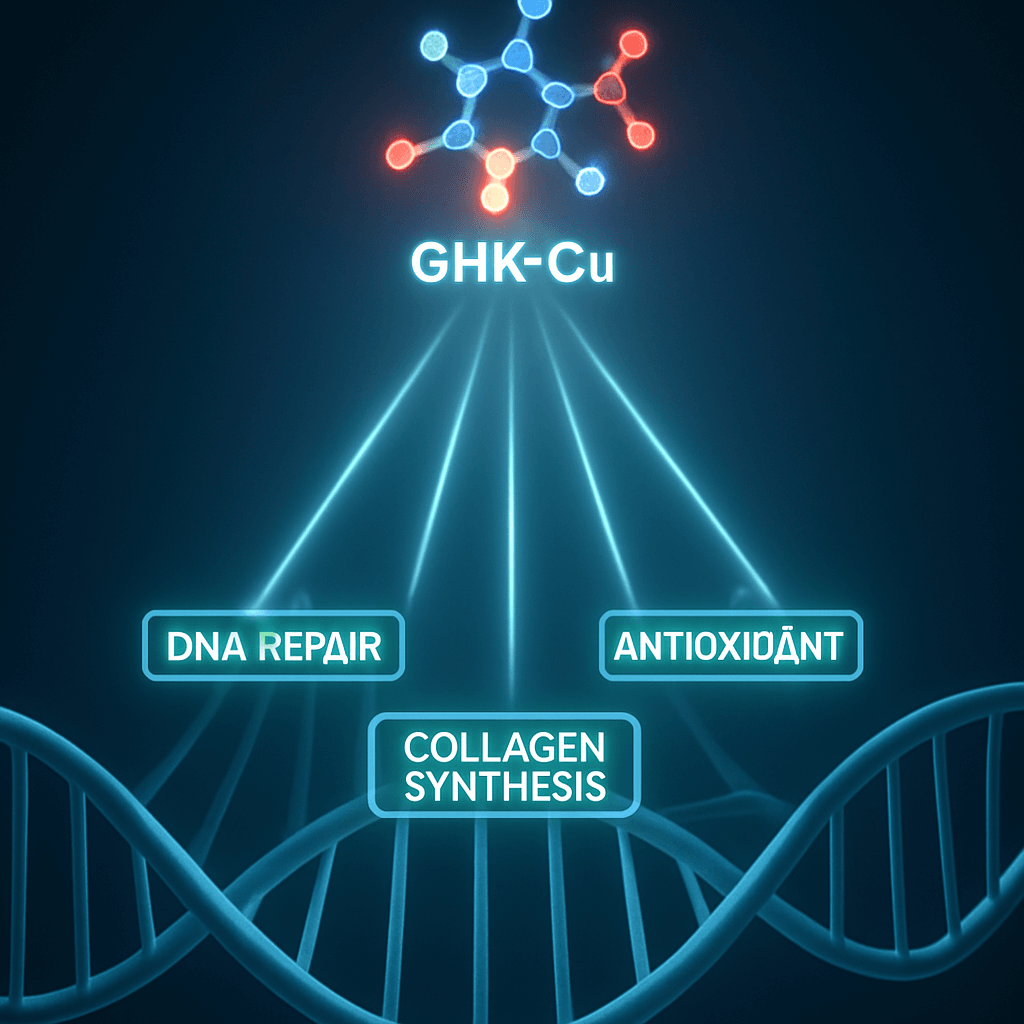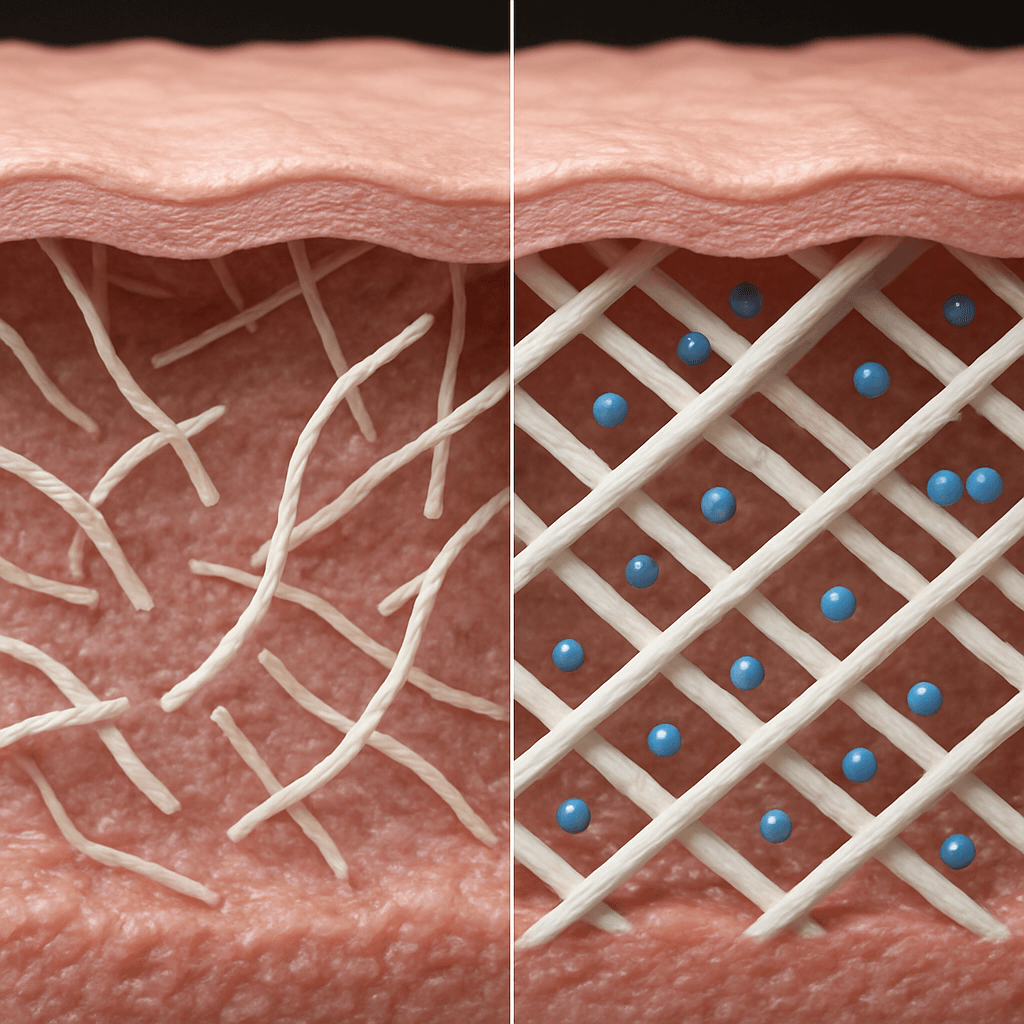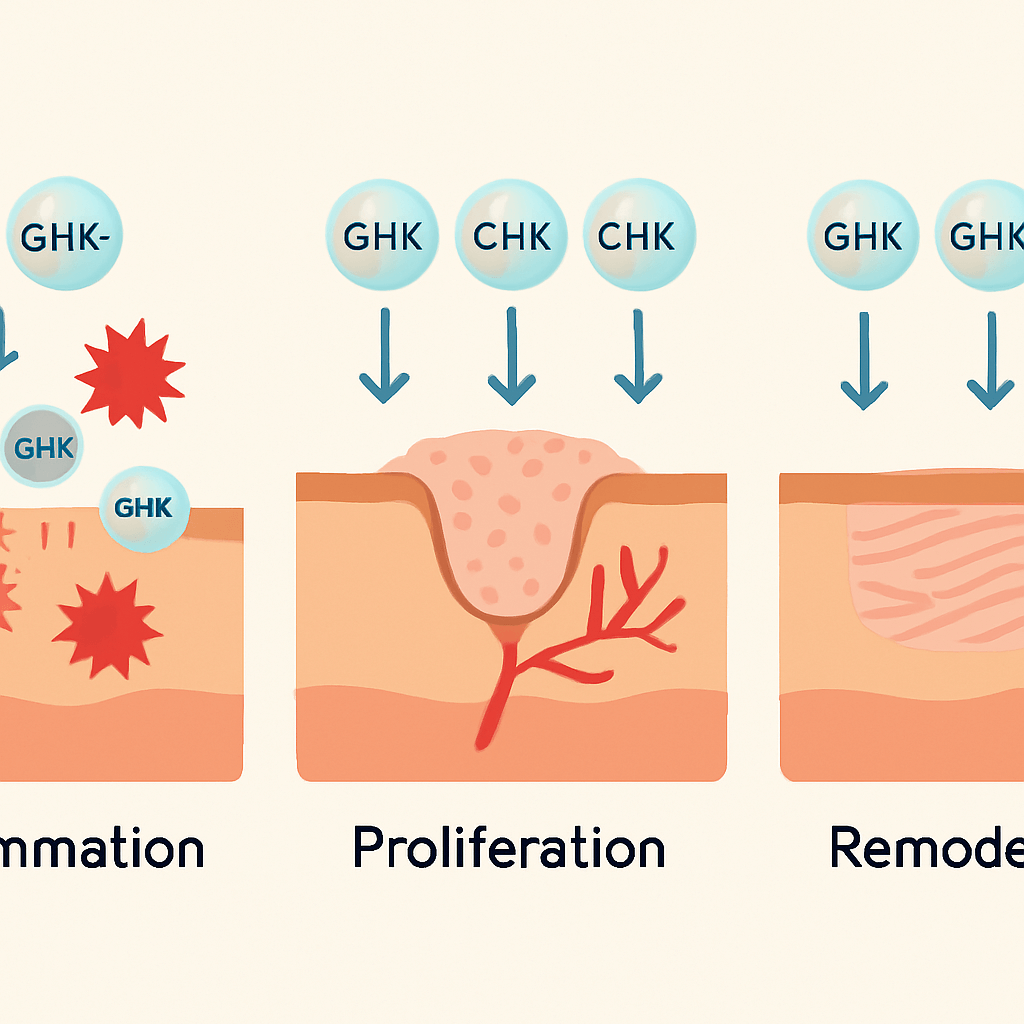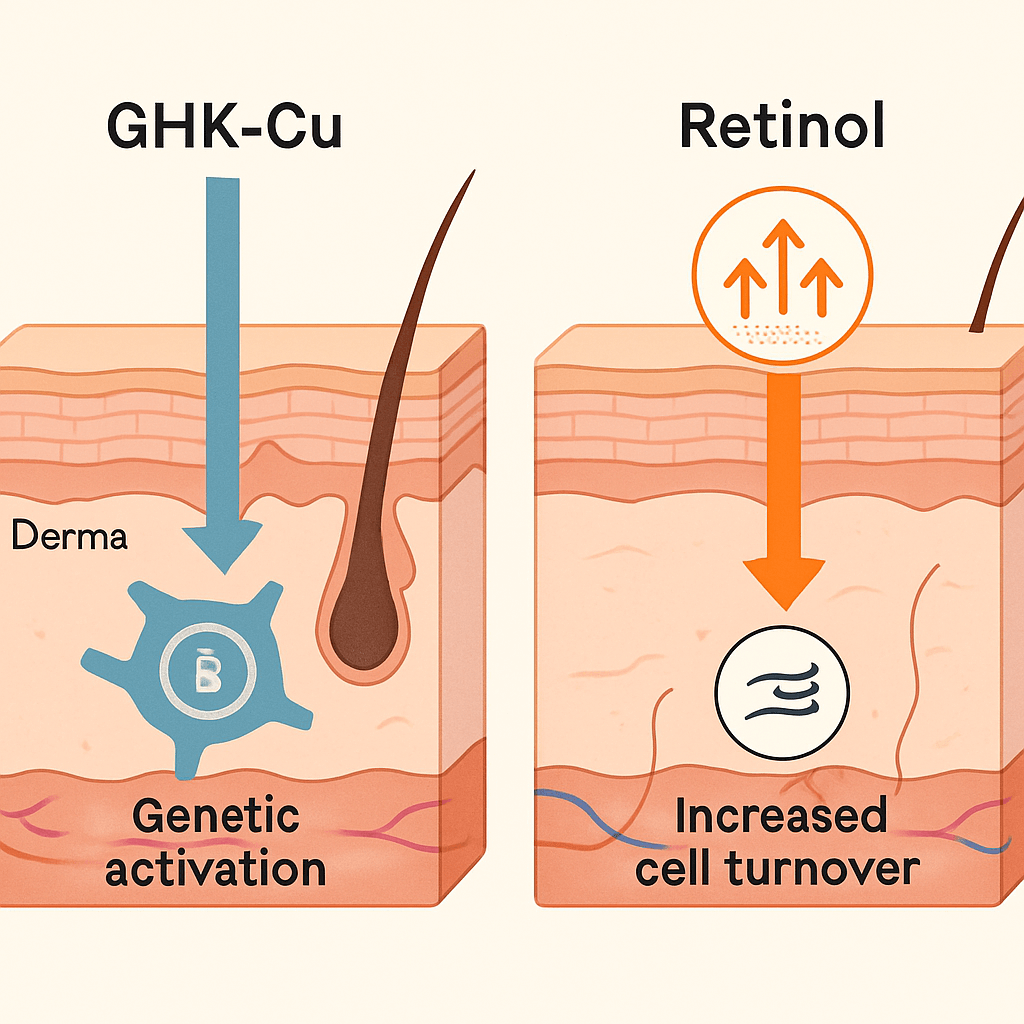
GHK-Cu (Copper Peptide): A Clinical Review of its Mechanisms for Advanced Wound Healing and Hair Follicle Regeneration
The Central Controller: A Clinical Review Unifying GHK-Cu's Diverse Regenerative Benefits
While the cosmetic and therapeutic benefits of the tripeptide GHK-Cu (glycyl-L-histidyl-L-lysine) are often discussed in isolation—skin repair here, hair growth there, wound healing elsewhere—this siloed view obscures the profound simplicity of its power. This fragmented perspective fails to answer the fundamental question: How can a single molecule exert such a wide range of positive biological effects? What if one core mechanism could explain it all?
This clinical review synthesizes decades of research to present a unified theory of GHK-Cu as a systemic regenerative modulator. Drawing from foundational studies on gene expression and cellular signaling, this paper moves beyond a mere list of benefits to explain the foundational biological process that makes them possible. We will explore the primary GHK-Cu mechanism of action to provide a comprehensive framework for clinicians and researchers.
This analysis will deconstruct GHK-Cu's role as a master controller of gene expression, tracing this primary action to its downstream effects on the extracellular matrix and systemic inflammation. Subsequently, we will analyze its clinical applications in advanced wound care, dermatology, and trichology, culminating in a nuanced comparative analysis against other common therapeutic agents. The goal is to reframe the understanding of GHK-Cu from a multi-purpose tool to a central orchestrator of cellular health and tissue regeneration.
Gene Expression Modulation: GHK-Cu as the Master Switch
The central thesis for understanding GHK-Cu's pleiotropic effects is its function as a powerful modulator of gene expression. Rather than acting on a single receptor or pathway, GHK-Cu initiates a cascade of genomic changes, effectively resetting a significant portion of the human genome towards a younger, healthier state. This function is not merely supportive; it is directive, positioning GHK-Cu as a master switch for cellular repair and regeneration.
The "Genomic Reset": Influencing Over 4,000 Human Genes
The foundational GHK-Cu research conducted by Dr. Loren Pickart and his colleagues provides the critical evidence for this genomic reset. Their microarray studies revealed that GHK-Cu can alter the expression of over 4,000 human genes, effectively reversing the expression patterns of many genes associated with degenerative diseases and aging. As GHK levels naturally decline with age, this discovery suggests that supplementation can restore a more youthful cellular environment.

GHK-Cu initiates a cascade of genomic changes, effectively resetting cellular function towards a younger, healthier state.
According to primary research published in sources cataloged by the National Center for Biotechnology Information (NCBI), GHK-Cu upregulates genes involved in critical repair and maintenance processes while downregulating those associated with inflammation and tissue breakdown. Key gene groups positively affected include:
Antioxidant and Anti-inflammatory Pathways: Upregulating genes for antioxidant enzymes and downregulating pro-inflammatory cytokine genes.
DNA Repair Mechanisms: Activating genes responsible for repairing damaged DNA, a cornerstone of cellular health and cancer prevention.
Collagen & Elastin Synthesis: Stimulating genes that code for the primary structural proteins of the extracellular matrix.
Cell Adhesion and Proliferation: Promoting genes that facilitate tissue structure and organized healing.
Conceptual Infographic: Gene Modulation Cascade
This visual would depict a single GHK-Cu molecule at the top. An arrow points down to a representation of a DNA double helix, where specific gene segments (labeled "DNA Repair," "Antioxidant," "Collagen Synthesis") are shown "lighting up" or activating. From this central point, multiple arrows branch out, leading to icons representing the downstream effects: a healed wound, a strong hair follicle, and smooth, firm skin. The visual reinforces the concept of a single input initiating a cascade of positive outcomes.
This ability to influence GHK-Cu gene expression on such a massive scale is the core of its therapeutic potential. It is not a targeted drug but a systemic regulator that encourages the body's innate repair systems to function optimally.
Deconstructing the Downstream Effects: From Genes to Tissue
Understanding that GHK-Cu modulates thousands of genes is the first step. The next is to connect this abstract genomic activity to the tangible, physiological results observed in human tissue. This translation from gene to tissue occurs primarily through two interconnected pathways: the remodeling of the extracellular matrix and the systemic regulation of inflammation and oxidative stress.
Extracellular Matrix (ECM) Remodeling & Structural Integrity

By stimulating synthesis and regulating degradation, GHK-Cu comprehensively remodels the skin's foundational structure.
The extracellular matrix is the non-cellular scaffold that provides structural and biochemical support to surrounding cells. Its integrity is paramount for tissue health, from skin elasticity to wound closure. GHK-Cu's gene modulation directly orchestrates ECM remodeling through a dual-action mechanism:
Stimulation of Synthesis: It upregulates the genes responsible for producing key structural proteins. This includes increasing the synthesis of collagen (types I and III), elastin, proteoglycans, and glycosaminoglycans. This enhanced production of GHK-Cu collagen and other components rebuilds and fortifies the ECM.
Regulation of Degradation: Simultaneously, GHK-Cu modulates the activity of matrix metalloproteinases (MMPs) and their inhibitors (TIMPs). MMPs are enzymes that break down ECM components. By inhibiting excessive MMP activity, GHK-Cu prevents the premature degradation of the matrix, creating a net positive balance toward tissue construction.
This comprehensive control over extracellular matrix remodeling is the fundamental reason for GHK-Cu's efficacy in both anti-aging applications and the structural phase of wound healing.
Systemic Anti-inflammatory & Antioxidant Control
Chronic inflammation and oxidative stress are hallmarks of aging and impede effective tissue repair. GHK-Cu exerts systemic control over these processes at the genetic level. Clinical research measuring inflammatory markers has demonstrated that GHK-Cu administration can significantly reduce pro-inflammatory signals.
Its mechanism involves the downregulation of key pro-inflammatory cytokines, most notably Tumor Necrosis Factor-alpha (TNF-α) and Interleukin-6 (IL-6). This cytokine regulation helps quell the excessive inflammatory response that can lead to tissue damage and scarring.
Concurrently, GHK-Cu upregulates the expression of crucial endogenous antioxidant enzymes, such as superoxide dismutase (SOD). By bolstering the body's own antioxidant defenses, it neutralizes free radicals and reduces oxidative damage. This dual anti-inflammatory and antioxidant action makes it one of the more effective antioxidant peptides, creating a cellular environment conducive to healing and regeneration rather than degradation.
Clinical Applications: The Unified Mechanism in Practice
The true value of this unified theory is demonstrated when the core mechanisms—gene modulation, ECM remodeling, and inflammation control—are observed producing tangible results in clinical settings. The seemingly disparate benefits of GHK-Cu in wound care, hair restoration, and dermatology are, in fact, different expressions of the same foundational biological process.
Advanced Wound Healing & Tissue Repair
Effective GHK-Cu wound healing is a prime example of its unified mechanism at work. The process of tissue repair is complex, but GHK-Cu intervenes at every critical stage:

GHK-Cu intervenes at every critical stage of tissue repair, leading to more organized and efficient healing.
Inflammatory Phase: Its potent anti-inflammatory action modulates the initial response, preventing chronic inflammation that can stall the healing process.
Proliferative Phase: It stimulates the production of collagen and other ECM components, providing the scaffold for new tissue growth. It also promotes angiogenesis (the formation of new blood vessels), which is critical for delivering oxygen and nutrients to the wound bed.
Remodeling Phase: It regulates the balance between collagen synthesis and degradation (via MMPs), ensuring the formation of strong, organized tissue rather than weak scar tissue.
This comprehensive intervention makes peptide therapy for tissue repair with GHK-Cu exceptionally effective for chronic wounds, burns, and post-surgical recovery.
Conceptual Infographic: GHK-Cu in the Three Phases of Wound Healing
This graphic would show three panels side-by-side: "1. Inflammation," "2. Proliferation," and "3. Remodeling." In Panel 1, a GHK-Cu icon is shown reducing "red" inflammatory cytokine symbols. In Panel 2, the icon is shown stimulating fibroblast activity and the laying down of a collagen matrix. In Panel 3, the icon is shown organizing the collagen fibers into a strong, linear pattern, contrasting with a disorganized scar tissue pattern.
Hair Follicle Regeneration & Anchoring
The application of GHK-Cu for hair growth is not due to a separate, hair-specific mechanism. Instead, it leverages the same principles of ECM remodeling and inflammation control. A healthy hair growth cycle depends on a robust follicle anchored firmly within the dermis. GHK-Cu strengthens this anchor by increasing the production of collagen and other structural proteins in the follicular sheath.
Furthermore, its anti-inflammatory properties create a healthier scalp environment, reducing the micro-inflammation that is often implicated in conditions like androgenetic alopecia. By improving the structural integrity and reducing inflammatory stress, GHK-Cu supports hair follicle regeneration and can increase hair thickness and follicle size.
Dermatological Anti-Aging & Skin Remodeling
The widely recognized anti-aging effects of GHK-Cu for skin are a direct and predictable outcome of its foundational mechanism. Wrinkle formation and loss of skin elasticity are primarily caused by the age-related decline in collagen and elastin production and the subsequent degradation of the ECM.
By resetting gene expression to favor the synthesis of these proteins, GHK-Cu effectively rebuilds the dermal matrix from the inside out. This leads to clinically observable improvements in skin firmness, elasticity, and density, and a reduction in fine lines and wrinkles. Unlike topical treatments that may only affect the surface, GHK-Cu initiates a deep, structural remodeling, making copper peptides anti-aging therapies a cornerstone of regenerative dermatology.
Comparative Analysis: GHK-Cu vs. Other Modalities
To fully appreciate the unique position of GHK-Cu, a mechanism-based comparison against other common agents is essential. This analysis highlights its role as a foundational, systemic modulator rather than a targeted agent, filling a critical gap in therapeutic strategies.
vs. BPC-157 (Systemic Repair)
BPC-157 is another peptide renowned for its systemic repair capabilities. However, its primary mechanism of action is understood to be the upregulation of growth hormone receptors and the promotion of angiogenesis through the VEGF pathway. While highly effective, it acts primarily on signaling cascades related to blood vessel formation and growth factor sensitivity. GHK-Cu, in contrast, operates at a more fundamental level, orchestrating repair by resetting the genetic blueprint for thousands of genes related to repair, inflammation, and antioxidant defense. It influences the entire cellular environment, whereas BPC-157 targets more specific repair pathways.
vs. Minoxidil (Hair Growth)
Minoxidil is a widely used pharmaceutical for hair loss. Its primary mechanism is vasodilation—widening blood vessels to increase blood flow to the hair follicle—and it may also work by opening potassium channels. This approach provides more nutrients to the follicle but does not address the structural integrity of the follicle's anchor or the underlying inflammatory state of the scalp. GHK-Cu works by remodeling the ECM to strengthen the follicle's foundation and by reducing local inflammation, addressing the root structural and environmental causes of hair thinning rather than just improving circulation.
vs. Retinol (Skin Anti-Aging)
Retinoids, such as retinol, are a gold standard in dermatology. Their primary mechanism involves increasing the rate of epidermal cell turnover, which helps to exfoliate the skin surface, clear pores, and stimulate some collagen production as a secondary effect of the cellular response. GHK-Cu's approach is fundamentally different. It does not primarily focus on cell turnover. Instead, it directly stimulates the fibroblasts within the dermis at a genetic level to build new collagen and elastin, rebuilding the skin's structural support from the bottom up. It is a constructive, remodeling agent, whereas retinol is primarily a regulator of cellular differentiation and turnover.

GHK-Cu works from the bottom up by rebuilding the skin's foundation, a fundamentally different approach than top-down surface renewal.
Conclusion
GHK-Cu is not merely a multi-benefit peptide; it is a systemic regenerative modulator whose power lies in its single, unified mechanism of action. By resetting the expression of over 4,000 human genes, it orchestrates a biological shift towards a state of health, repair, and regeneration. The clinical outcomes observed across dermatology, wound care, and hair restoration are not separate phenomena but are the downstream consequences of this central genomic control.
This unified theory reframes our understanding of the peptide. From the accelerated healing of a chronic wound to the increased density of hair or the reduction of fine lines, the underlying principle is the same: GHK-Cu restores the cellular machinery responsible for building and maintaining healthy tissue. For practitioners and researchers, this perspective should inspire a paradigm shift—to view GHK-Cu not as a targeted treatment for isolated symptoms, but as a foundational tool for orchestrating systemic health and regeneration. By leveraging its ability to act as the body's own central controller, we can unlock more profound and integrated therapeutic outcomes.
MDRX Network, LLC
Phone: 832-500-7888
Email: [email protected]
